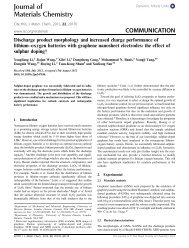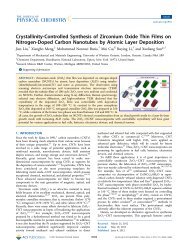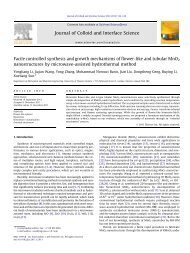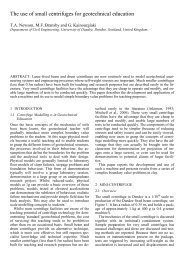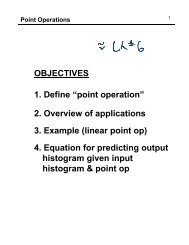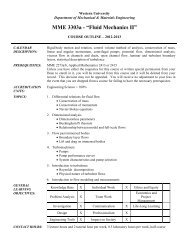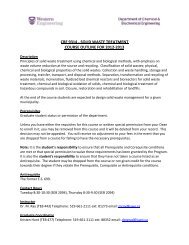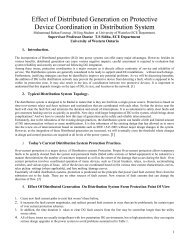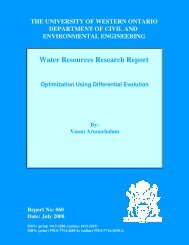Physical Modelling of the Upheaval Resistance of Buried Offshore ...
Physical Modelling of the Upheaval Resistance of Buried Offshore ...
Physical Modelling of the Upheaval Resistance of Buried Offshore ...
Create successful ePaper yourself
Turn your PDF publications into a flip-book with our unique Google optimized e-Paper software.
Gravel<br />
berm<br />
Loose<br />
sand<br />
Pipe<br />
(a) (b)<br />
Figure 12. Soil deformation: loose sand with gravel berm<br />
(C8) at different stages <strong>of</strong> <strong>the</strong> test.<br />
ra<strong>the</strong>r than <strong>the</strong> pipe diameter/embedment. The<br />
mobilised displacement ratios to peak load, δ/H ≈<br />
0.5 % and <strong>the</strong>se agree well with previous workers<br />
(eg. Matyas and Davis, 1983; Trautmann et al.,<br />
1985).<br />
As shown earlier, <strong>the</strong> uplift force for loose sand<br />
may be predicted conservatively using <strong>the</strong> vertical<br />
slip surface model (Majer; 1955) and using φ RQ WKH<br />
slip surface, and Ko = 1 – sin(φ WKH DW UHVW ODWHUDO<br />
earth pressure coefficient (Figure 4) despite <strong>the</strong><br />
different post-failure mechanism observed. The<br />
load-displacement response for <strong>the</strong> dense sand and<br />
gravel shows a peak uplift resistance before <strong>the</strong><br />
uplift resistance reduces to a residual value similar to<br />
<strong>the</strong> values for a loose sand. The dense soil sample is<br />
dilating, but <strong>the</strong>n post-peak strain s<strong>of</strong>tening reduces<br />
<strong>the</strong> mobilised angle <strong>of</strong> friction to φ’ as for <strong>the</strong> loose<br />
sand tests.<br />
5 SUMMARY AND CONCLUSIONS<br />
Tests have been carried out to study <strong>the</strong> uplift<br />
behaviour <strong>of</strong> pipelines in <strong>the</strong> laboratory and <strong>the</strong><br />
geotechnical centrifuge. The pipes were <strong>of</strong> prototype<br />
diameter 32 mm, 48 mm, 240 mm and 250 mm and<br />
soil conditions consisted <strong>of</strong> dry, loose or dense sand<br />
or gravel with or without a berm.<br />
Uplift factors are presented for <strong>the</strong> tests. Loose<br />
sand gave fd ≈ 0.5. Dense sand and gravel gave a<br />
peak uplift factor, fd > 1 on initial loading, but this<br />
reduced to a residual value, fd ≈ 0.6 after a<br />
displacement that may be proportional to <strong>the</strong><br />
diameter <strong>of</strong> <strong>the</strong> soil particles. For design, it is<br />
<strong>the</strong>refore important to ei<strong>the</strong>r know <strong>the</strong> density <strong>of</strong> <strong>the</strong><br />
seabed or o<strong>the</strong>rwise use a conservative uplift factor.<br />
The load-displacement behaviour <strong>of</strong> <strong>the</strong> pipes<br />
shows <strong>the</strong> displacement required to mobilise full soil<br />
resistance, δ/H ≈ 0.4 % for all loose sand tests. Peak<br />
load is mobilised more quickly in dense soil (δ/H ≈<br />
0.1 %).<br />
Soil deformation mechanisms were examined by<br />
taking digital photographs/video <strong>of</strong> <strong>the</strong> front face <strong>of</strong><br />
<strong>the</strong> test box. Photographs are presented which<br />
indicate soil displacement mechanisms after failure<br />
for <strong>the</strong> different soil types. These vary with initial<br />
soil density, but all included gap formation behind<br />
<strong>the</strong> pipe while <strong>the</strong> peak uplift force is being<br />
mobilised and soil flow around <strong>the</strong> pipe after failure.<br />
Results from centrifuge model tests with gravel<br />
berms showed a significant increase in uplift<br />
capacity (fd ≈ 0.8) but a less significant increase was<br />
found for sand berms. It is believed that dilation <strong>of</strong><br />
<strong>the</strong> berm during initial pipe displacement toge<strong>the</strong>r<br />
with <strong>the</strong> weight <strong>of</strong> <strong>the</strong> berm increases <strong>the</strong> uplift<br />
capacity.<br />
ACKNOWLEDGEMENTS<br />
The work described in this paper was supported by<br />
funds from Stolt <strong>Offshore</strong> and this support is<br />
gratefully acknowledged. The authors would like to<br />
thank Mr. Colin Fyfe and Dr. Shiping Yao for <strong>the</strong>ir<br />
hard work during <strong>the</strong> testing programme and to <strong>the</strong><br />
technical staff <strong>of</strong> <strong>the</strong> Department <strong>of</strong> Civil<br />
Engineering, University <strong>of</strong> Dundee for all <strong>of</strong> <strong>the</strong>ir<br />
help.<br />
REFERENCES<br />
Bransby, M.F., Newson, T.A., Brunning, P., Davies, M.C.R.<br />
(2001). Numerical and centrifuge modelling <strong>of</strong> <strong>the</strong> upheaval<br />
resistance <strong>of</strong> buried pipelines. Proc <strong>of</strong> OMAE pipeline<br />
symposium, Rio de Janeiro, June 2001.<br />
Dickin, E.A. (1994) Uplift <strong>Resistance</strong> <strong>of</strong> <strong>Buried</strong> Pipelines in<br />
Sand. Soils and Foundations, Vol.34, No.2, p 41-48.<br />
Finch. M, Fisher. R, Palmer A, and Baumgard. A, (2000). An<br />
Integrated Approach to Pipeline Burial in <strong>the</strong> 21 st Century,<br />
Deep <strong>Offshore</strong> Technology 2000.<br />
Majer, J. (1955) Zur berechnung von zugfundamenten.<br />
Osterreichister Bauzeitschift, 10, 5, p. 85-90.<br />
Matyas, E.L. & Davis, J.B. (1983) Prediction <strong>of</strong> vertical earth<br />
loads on rigid pipes. J. Geo. Eng. Div., ASCE, 109, GT2, p.<br />
190-201.<br />
Moradi, M. & Craig, W.H. (1998) Observation <strong>of</strong> <strong>Upheaval</strong><br />
Buckling <strong>of</strong> <strong>Buried</strong> Pipelines. Centrifuge 98, Kimura,<br />
Kusakabe & Takemura (eds), p 693-698.<br />
Ng, C.W.W. & Springman, S.M. (1994) Uplift <strong>Resistance</strong> <strong>of</strong><br />
<strong>Buried</strong> Pipelines in Granular Materials. Centrifuge 94, Leung,<br />
Lee& Tan (eds), p 753-758.<br />
Schaminee, P.E.L., Zorn, N.F. and Schotman, G.J.M. (1990)<br />
Soil Response for Pipeline <strong>Upheaval</strong> Buckling Analyses:<br />
Full-Scale Laboratory Tests and <strong>Modelling</strong>. OTC 6486, 22 nd<br />
Annual <strong>Offshore</strong> Technology Conference, Houston, Texas,<br />
May 7-10, 563-572.<br />
Sch<strong>of</strong>ield, A.N. (1980). Cambridge University Geotechnical<br />
Centrifuge Operations. Rankine lecture, Geotechnique 30,<br />
No. 3, pp. 227-268.<br />
Trautmann, C.H, O’Rourke, T.D. and Kulhaway, F.H. (1985)<br />
Uplift Force-Displacement Response <strong>of</strong> <strong>Buried</strong> Pipe. Journal<br />
<strong>of</strong> Geotechnical Engineering, Vol.111, No.9, p. 1061-1076.





